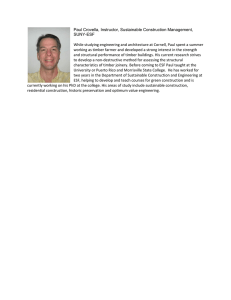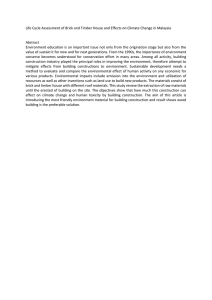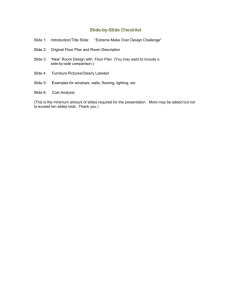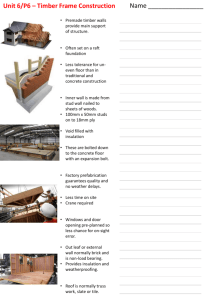5. Installation
advertisement
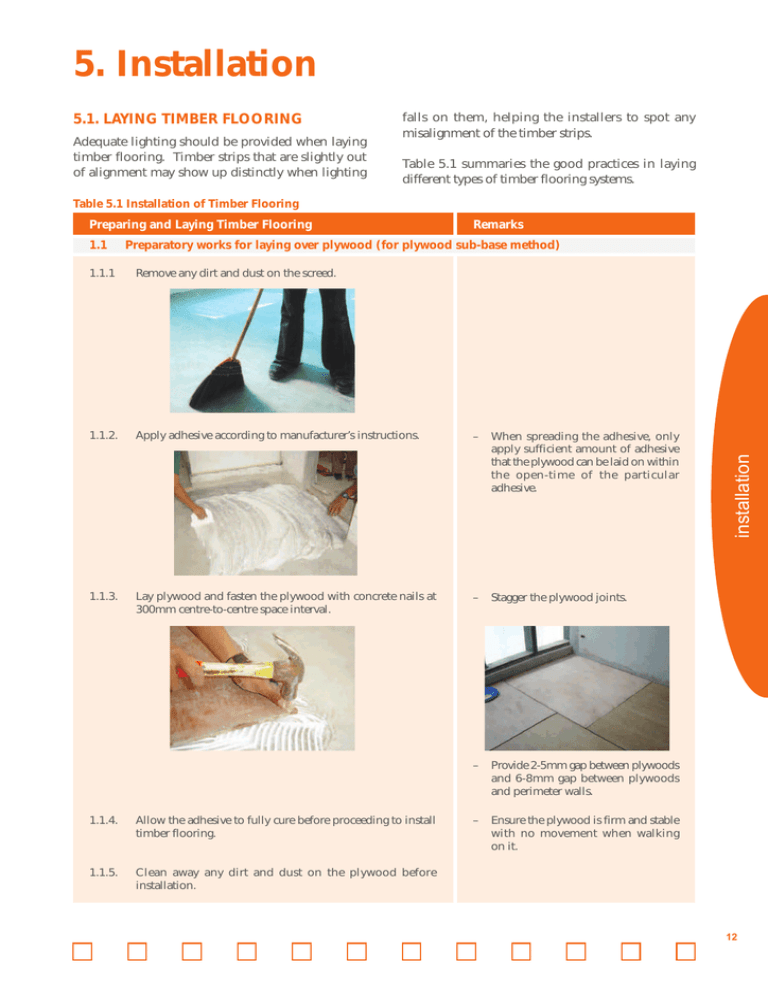
5. Installation 5.1. LAYING TIMBER FLOORING Adequate lighting should be provided when laying timber flooring. Timber strips that are slightly out of alignment may show up distinctly when lighting falls on them, helping the installers to spot any misalignment of the timber strips. Table 5.1 summaries the good practices in laying different types of timber flooring systems. Table 5.1 Installation of Timber Flooring Preparing and Laying Timber Flooring Preparatory works for laying over plywood (for plywood sub-base method) 1.1.1 Remove any dirt and dust on the screed. 1.1.2. Apply adhesive according to manufacturer’s instructions. – When spreading the adhesive, only apply sufficient amount of adhesive that the plywood can be laid on within the open-time of the particular adhesive. 1.1.3. Lay plywood and fasten the plywood with concrete nails at 300mm centre-to-centre space interval. – Stagger the plywood joints. – Provide 2-5mm gap between plywoods and 6-8mm gap between plywoods and perimeter walls. – Ensure the plywood is firm and stable with no movement when walking on it. 1.1.4. Allow the adhesive to fully cure before proceeding to install timber flooring. 1.1.5. Clean away any dirt and dust on the plywood before installation. installation 1.1 Remarks 12 Preparing and Laying Timber Flooring 1.2 1.2.1. installation 2. Remarks Preparatory works for laying of timber flooring (for direct installation method) Remove any dirt and dust on the screed. – It is a good practice to vacuum the screed surface as any presence of granular particles trapped between the timber strips may cause inconsistent joints. Laying timber flooring 2.1. Apply adhesive according to manufacturer’s instructions. 2.2. Lay timber flooring. Where possible, use a floor nailing machine after the second or third run is in place. – Laying directly over screed using adhesive; or – Laying over plywood with tongue and groove. – When spreading the adhesive, only apply sufficient amount of adhesive that the timber flooring can be laid on within the open-time of the particular adhesive. – Where appropriate, maintain full width of timber strip at the door entrance or as per approved shop drawings. – The use of nailing machine is preferred as it drives nails mechanically or pneumatically through the tongue of the flooring at proper angle. – Avoid nailing into the plywood joints. Position the floor strips so that they do not meet at the plywood joints. – To minimise inconsistent joint, timber strips should be “pressed-in” to enhance bonding and close up the gap between the strips. – Wedges should be provided at the perimeters of the room to prevent any movement during the curing process. 13 Preparing and Laying Timber Flooring – Remarks Leave expansion gap of 6-8mm at the perimeters of the room. 2.3. Allow the floor to cure for a minimum of 3 weeks (or period specified by manufacturer). Restrict access to the area during the curing period. – For proper curing, flooring should not be covered during the curing period. Do not allow anything to spill on the timber flooring as this may contaminate the final finishes. 2.4. Remove perimeter wedges and check for loose timber strips. – Rectify any loose timber strips according to manufacturer’s instructions. installation – All wood products expand and contract with humidity changes. The expansion gap provided will allow for such dimensional changes. 14 5.2. SANDING The timber floor should be sanded before applying the finishing coat to give a smooth and level surface. The number of sanding operations depends on the type of timber flooring and the level of unevenness of the floor. Manufacturer’s advice should be consulted on the number of sanding operations required. Normally, 3 to 4 sanding operations are required. The 1st sanding should produce a level and completely sanded surface. Subsequent sanding operations would then serve to remove the sanding scratches produced by the 1st sanding. Table 5.2 shows the commonly used floor sanding grits defined by NOFMA*: The Wood Flooring Manufacturers Association and Table 5.3 shows good work practices to be adopted when sanding timber flooring. Unless otherwise specified by the manufacturer, the sanding sequence shown in Figure 5.1 should be followed. Table 5.2 Commonly used Floor Sanding Grits Classifications Sanding Grits Coarse Medium Fine Very Fine 36,40 60,80 80,100,120 120,150 Source: NOFMA 1st sanding (either directions) 1st sanding 3rd sanding installation light incidence 2nd sanding subsequent sanding operations Sanding Sequence for Parquet Flooring Figure 5.1 Sanding Sequence for Timber Flooring *NOFMA - National Oak Flooring Manufacturers Association 15 Sanding Sequence for Timber Strips Flooring Table 5.3 Sanding Timber Floor Sanding Timber Floor Remarks 1. Before commencement of sanding, check for any protruding nail heads and remove them. – Sanding on exposed nails may produce sparks and cause a fire in the sander dust bag. – It is important that the correct type of sand papers are used for the various rounds of sanding. – Sand paper should be changed when necessary. Some timber species are highly resinous and tend to clog sandpaper. When working on such species, change the sandpaper more often. – At areas such as corners or edges of walls where the sanding machine cannot be reached, edge sander should be used. – The wood filler could be prepared by mixing the sanding dust of the last sanding operation and a gap filling adhesive solution. This filler should has a shade as close to that of the wood surface as possible. 3. Start the sanding operations. Clean the surface with a vacuum cleaner following each sanding operation. 4. Where applicable, apply a coat of wood filler to patch up nail holes and gaps, prior to the last sanding operation. installation 2. Clean the floor with a vacuum cleaner. 16 5.3. APPLYING FINISHING COAT Immediately after sanding is completed, the finishing coat should be applied. This will protect the exposed timber from getting dirty and absorbing excessive moisture. Finishing coat provides a uniformly enhanced surface and seals the timber flooring against moisture and foreign materials. Manufacturer’s instructions and recommendations should be followed when applying the finishing coat. Table 5.4 shows the steps required to achieve good timber flooring when applying the finishing coat. installation Table 5.4 Applying Finishing Coat Applying Finishing Coat Remarks 1. Sweep and vacuum the floor. Wipe and remove all dust on windows, doors, door frames, expansion gaps etc. – If surface is not properly cleaned, sand or dust may get stuck on the finishing coat and result in roughness of the finished surface. 2. Apply the finishing coat evenly with a surface brush or a roller. – The manufacturer’s guide on coverage should be strictly followed. – Start on the side of the light incidence and work away from the light. This allows better observation of the finished surface to spot and rectify any possible imperfections. – When applying finishing coat, avoid direct sun radiation on the surface as radiation may lead to the generation of blisters in the finishing coat. – – applying finishing coat with a surface brush applying finishing coat with a roller 3. Allow the finishing coat to dry according to manufacturer’s instructions. 17 Remarks 4. If abrasion is specified by designer, sand the flooring using a finishing sander with sand paper of very fine grit such as 150/180. – This sanding is to remove all risen wood grain and to smoothen the flooring. 5. Clean the flooring with a vacuum cleaner. Wipe and remove all dust on windows, doors, door frames etc. – This is to make sure no dust is stuck on the newly finished surface. 6. Apply the second finishing coat according to the same application procedure for the first coat. – To enhance the resistance of the timber flooring, a third coat may be applied in the same way after the floor is dry. 7. Leave the finished flooring to cure for minimum 7 days (or follow manufacturer’s recommendation) before covering or protecting the surface. During this curing period, restrict access to the room. installation Applying Finishing Coat 5.4. INSTALLING TIMBER SKIRTING The installation of skirting involves using adhesive and concrete nails to secure the skirting in place (see Figure 5.2). The nails could be temporarily or permanently secured to the skirting. For temporary securing, the nails should only be partially hammered in to facilitate easy removal at a later stage. For permanently securing, headless concrete nails should be used. Thereafter, nail holes should be concealed with matching wood filler and sanded smooth before finishing. Figure 5.2 Installation of Timber Skirting 18 5.5. INSPECTION Close supervision should be provided for both in-process and finished works. In order to achieve high workmanship quality, it is important that quality control should be driven by the site management. Site supervisors and installers should be adequately trained and display competency in their works. Quality control starts with good planning. It is a good practice to prepare an Inspection and Test Plan, ITP (see Appendix B) which summaries the project’s inspection, acceptance criteria and the frequency of inspection. Appendix C shows a sample of inspection checklist for laying timber flooring. Site supervisor should carry out in-process inspection to ensure the steps are properly executed. Holding points should be set at critical stages where unsatisfactory work can be rectified before proceeding to the next stage of work. The finished works should be inspected to ensure they meet the client’s requirements and standards. Table 5.5 shows a recommended checklist for final inspection of timber flooring. The inspection criteria in the checklist are in accordance with the CONQUAS 21 quality assessment standards. Table 5.5 Checklist for Final Inspection of Timber Flooring Inspection Checklist 1. 1.1. CONQUAS 21 Assessment – Jointing No visible gap between timber strips installation ✓ Good jointing 1.2. ✗ Obvious gaps between timber strips Edges of the flooring to be properly sealed ✓ 1.3. No visible gap between skirting and wall/ timber flooring ✓ No visible gap between skirting and timber flooring 19 ✗ Uneven gap between skirting and timber flooring Inspection Checklist 2.1. CONQUAS 21 Assessment – Finishing No stain mark ✓ Good surface finishes 2.2. ✗ Paint stain Consistent colour tone ✓ Consistent tonality – pattern and shades are well blended 3. 3.1. ✗ Inconsistent tonality CONQUAS 21 Assessment – Alignment & Evenness Surface are even (not more than 3mm over 1.2m) ✓ Evenness ≤ 3mm per 1.2m 4. 4.1. ✗ installation 2. Evenness > 3mm per 1.2m CONQUAS 21 Assessment – Cracks & Damages No crack and other visible damage ✗ Crack ✗ Dent 20
